
| WWT Shows | CLICK TO: Join and Support Internet Horology Club 185™ | IHC185™ Forums |

|
• Check Out Our... • • TWO Book Offer! • |
Welcome Aboard IHC185™  Internet Horology Club 185
Internet Horology Club 185  IHC185™ Discussion Site Main Page
IHC185™ Discussion Site Main Page  Horological Discussions, Questions and Answers
Horological Discussions, Questions and Answers  European Pocket Watch Forum
European Pocket Watch Forum  Is this "Just another Center Sec Chrono"?
Is this "Just another Center Sec Chrono"?
 Internet Horology Club 185
Internet Horology Club 185  IHC185™ Discussion Site Main Page
IHC185™ Discussion Site Main Page  Horological Discussions, Questions and Answers
Horological Discussions, Questions and Answers  European Pocket Watch Forum
European Pocket Watch Forum  Is this "Just another Center Sec Chrono"?
Is this "Just another Center Sec Chrono"?Page 1 2
Go  | New Topic  | Find-Or-Search  | Notify  | Tools  | Reply to Post  |  |
| IHC Life Member |
I threw a number at this on eBay because it looks well Jeweled, is KWKS, has a stop-start side switch and appears to be English-Made. So I won it. Large piece 60mm Diameter. Anybody seen one of these before? The movement is marked MANCHESTER and a bunch of other stuff. More when I get it.  | ||
|
Well done Dave, you've won a very nicely jewelled English Lever chrono (as in stop watch). Also has a breguet overcoil hairspring and a cut bi-metalic balance plus timing screws! The screws will be real too, not the fake pins you sometimes get on similar stuff masquerading as better stuff. The screwed in jewels usually indicate a better than average English lever, and the stop watch function a nice addition. The rub is, you stop the seconds, you stop the watch! A pin attached to the side lever on the case actually (should) moves against the roller stopping the watch. sometimes the pin gets bent and hits either the jewel or the staff itself. Nice to see it's got all it's hands too, one or all three often go walkabout! Hands Could be solid Gold! Nice find and worth buying! John | ||||
|
| IHC Life Member |
Thank You John for the moral support. I sincerely hope it truly deserves your vivid description. I like these as I think they were early medical and sceintific support watches. One could suppose that the importance of timing something was greater therefore than the actual time, especially as the complication in the watch train necessary to keep the watch movement running while stopping the second hand is quite complex. b.t.w. I am confidant that among us all, we should be able to help you properly restore that 1857 model you have which enjoys the better quality compensated steel balance wheel, making it also a more practical "carry and show" piece! | |||
|
Any time Dave, and I'm pretty certain about my description of the movement. If I'm wrong and you hate it, heck I'll buy it off you It will be interesting to hear about the escapement when you receive the watch, because during the research I did on my H.White freesprung, I discovered that many of this type English lever were later modified by repairers to take a Swiss lever type escape wheel and pallet assembly. The English lever scape wheel is very similar in appearance to the 'Graham' dead beat scape wheel in a clock, and being very fine are easily damaged/worn and difficult to repair - they're also usually brass, whereas the Swiss wheel is steel. If still an English lever, your watch will have a steel pallet arm rivetted under the lever, but the pallet faces will most likely be slit and have Ruby slips inserted. You could even get lucky and find it has a later sidelever arm with Ruby pallets. Thanks for the help re the Waltham too, I've now stripped it and will be updating the topic a little later. John | ||||
|
| IHC Life Member |
The pallet appears to be "Kicking" the balance wheel in one direction only. But it is running smoothly. The Escapement wheel is brass and it appears the pallet lever is steel. Until this stops, I see just moving parts and a beautiful bridge that secures both the Escape wheel and the Pallet Fork 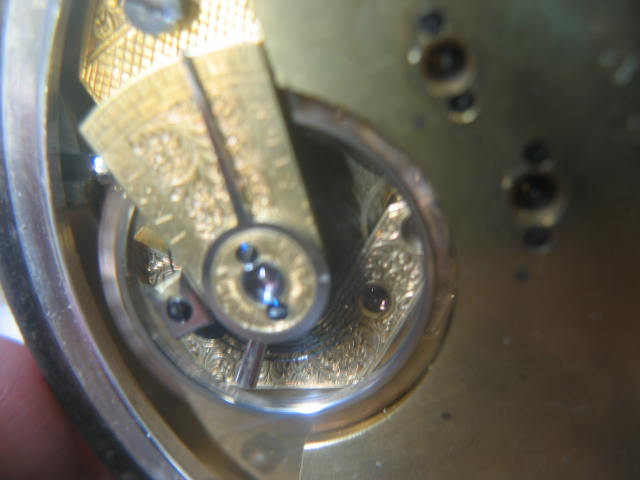 | |||
|
| IHC Life Member |
I must add that this is a "slow train" probably 16,000 or so. I admire the "stop" mechanism which is a lever that appears to gently arrest the lever motion on the "drop", so when the "start" is actuated the movement must immediately start up again. Also more detail of the movement marks; Center plate; "MANCHESTER" Perimeter left; "N. Tragheim" Perimeter Bottom; "39 Hanging Ditch" Perimeter Right; "No.92892" I will try to do some "super macro" shots soon. 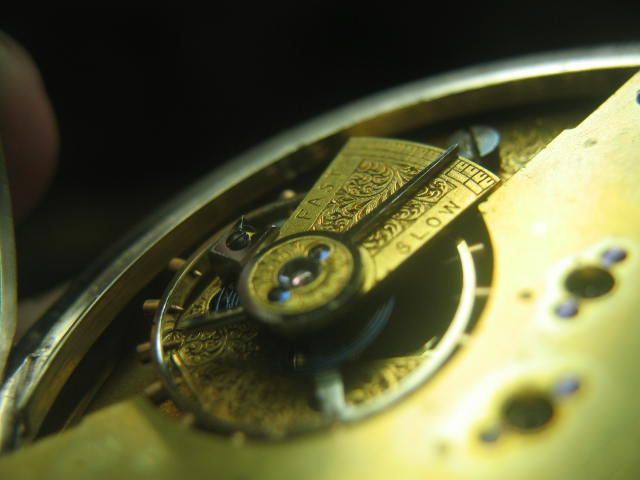 | |||
|
| IHC Life Member |
To my "unschooled eye" loking and peering about in there, the escapement looks like this one; 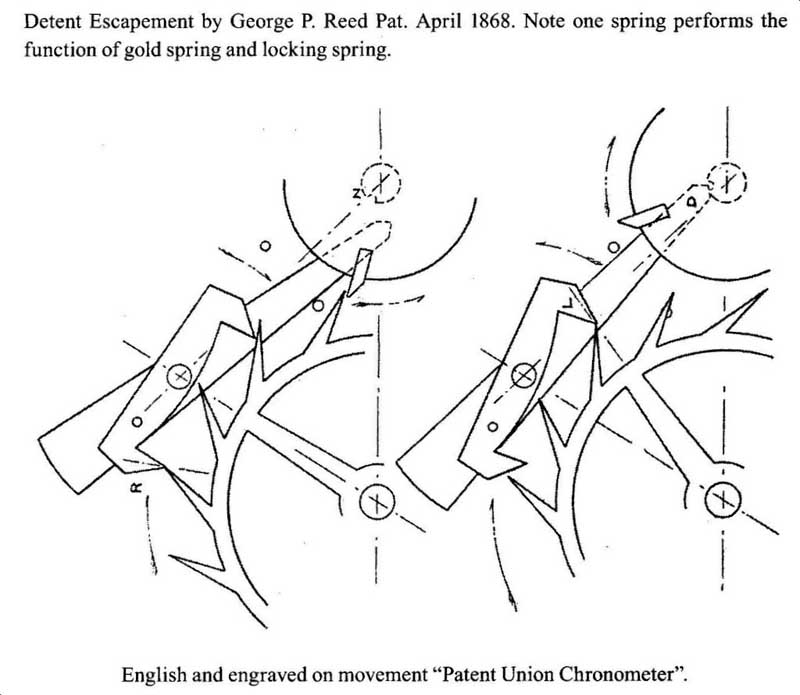 | |||
|
Did you ever determine the escapement type on this watch Dave? This type movement generally has an 18.000 train, but some variations exist, so you're not too far off the mark. I love these movements, sound like old Grandfather clocks ticking away - quite soporific in a quiet room! It'd be great if you had turned up a detent type, but I've a feeling if you stop the watch and peer in at the roller, you'll see a ruby jewel poking out of it vertically, and a fork end on the lever. I'm a bit puzzled why you think it unusual the watch should restart as soon as the lever is unhooked though, because any watch in reasonable nick should restart if the balance is stopped and let go. There's always usually sufficient force left in the hairspring to cause it to swing the balance when released and unlock the pallets. I suppose if the balance was stopped very close to the point where the lever was central or close to the banking pins and little residual power in the hairspring, a situation might arise where it wouldn't start again, but even then, the power in the train (unless fully unwound) would be sufficient to impulse the lever a short period sufficient to kick the roller and set it going again! You'd be very lucky to hit that spot one in a hundred shots. Releasing the wire from the roller will also cause some movement too, because of a slight sliding movement when it's released, mainly due to the wire being flexed slighty when under pressure from the stop lever. Looking forward to seeing those macro shots. Best regards John | ||||
|
| IHC Life Member |
Thanks John, I sent it to Chris as it was made in his "home town" and Chris confirmed it's a "plain old lever type (and is returning it to me). To better explain about the stop lever, what I really liked about this is that the stop mechanism simply detains (quite harmlessly) the pallet lever evidently when it is "dropping" so when it is released it will drop and "kick" the balance wheel. That is quite different from the little hair size spring that Hamilton put in their 4992 that simply skids along the side of the balance wheel so that when you release it the balance wheel may start up again. It's possible for the balance not to restart when it is stopped at the wrong spot and the slightest bit "sticky". | |||
|
Dave, I've dug out a similar centre seconds chrono movement and taken photo's of the stop lever and wire so that folks maybe understand better what this device is. As they go, they're about as 'agricultural' as can get in a watch - and about as subtle as a rubber cosh, but as you say, works well. The bent end should only catch the roller though, and are often found to be clipping anywhere from the pivot root to the balance arm - depending upon who's been poking around with a hatpin!! They're also often responsible for busting off the roller jewel! The chrome actuating lever can be seen just next to the balance rim with the wire leading from it, this lever hooks into the slider on the case. John 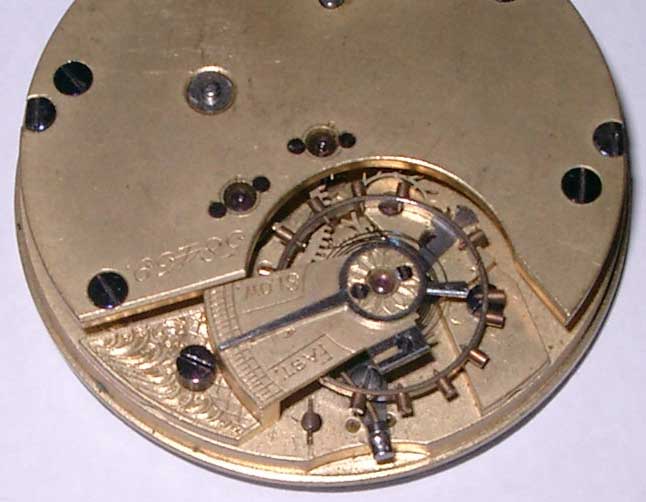 | ||||
|
Dial of the movement, shame about the busted 'Fleur de Lys' hand tip! JW. 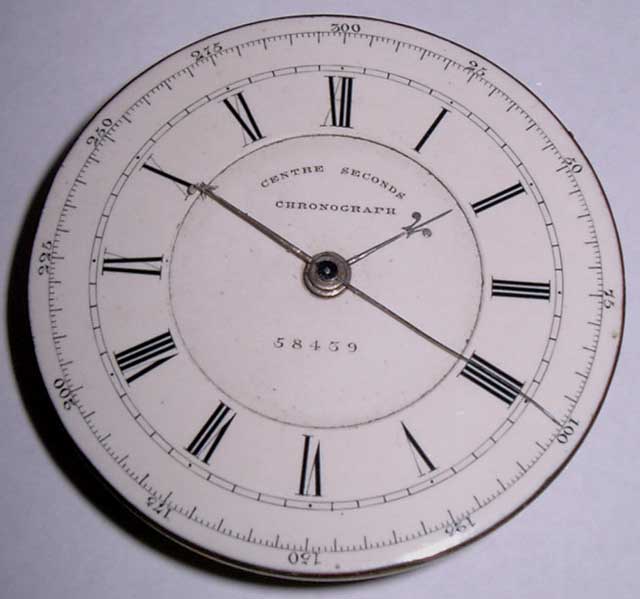 | ||||
|
Balance removed showing whole stop lever and wire. The 90deg cranked end isn't too easy to see. The lever simply pivots on the big centre screw. JW. 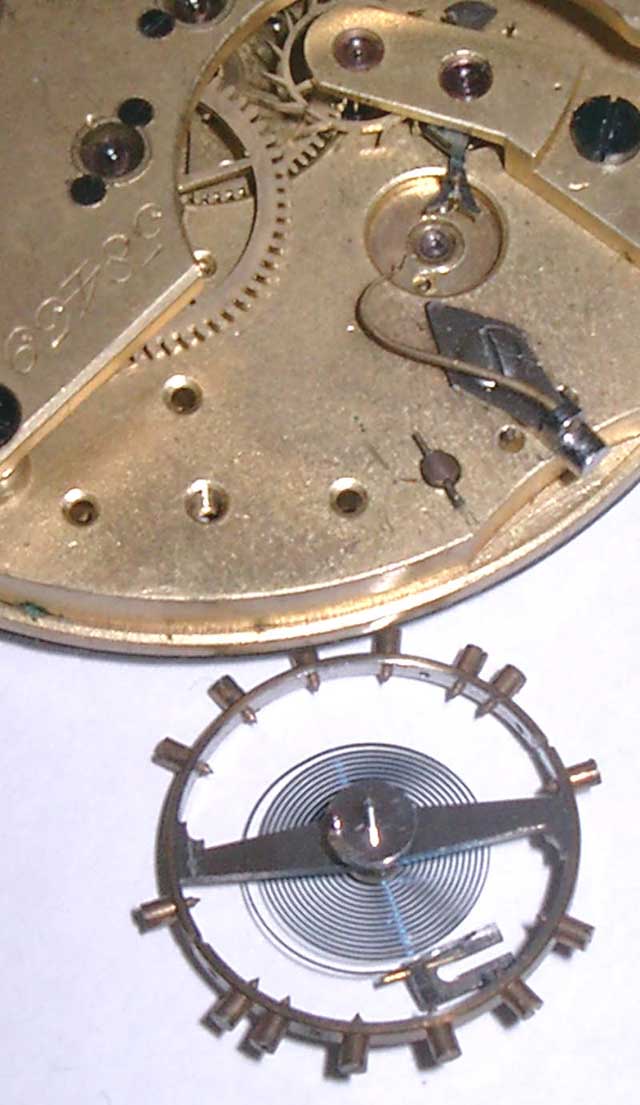 | ||||
|
Hopefully this will show the crank a tad clearer. JW. PS. Note the 'tasteful' repair to the barrel pivot hole! 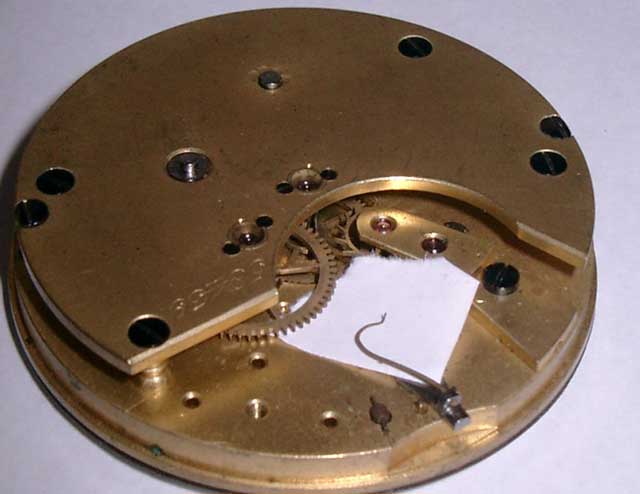 | ||||
|
Hi David, I don't know much about watches, but I do know a little about N. Tragheim if you're interested. His first name was Nicolai and he was a relative of mine. Originally from Latvia (although it was part of Russia at the time), he emigrated to Manchester in the mid-1850s and was involved in Tragheim & Co., which was a lace-maker. If you still have this watch I'd be interested in talking to you about acquiring it. I don't have any heirlooms from that branch of my mother's family. | ||||
|
This looks a lot like your watch, Dave 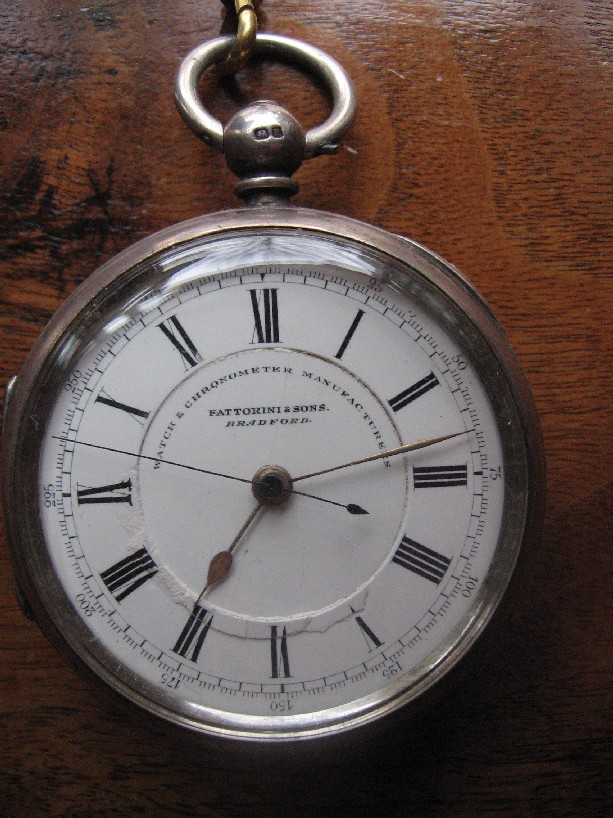 | ||||
|
Here is the dust cover. 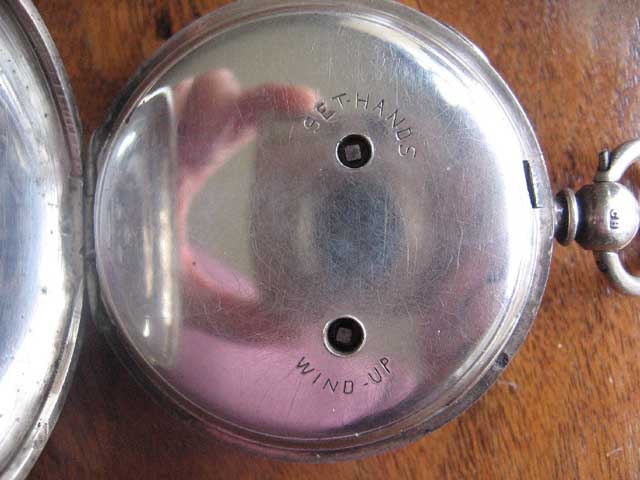 | ||||
|
The movement isn't as high grade as yours.  | ||||
|
I haven't tried to look up the hallmarks yet.  | ||||
|
I did find something on the Fattorini company on the internet, though. Antonio Fattorini was an Italian inigrant who founded a company in England in 1831. He started as a travelling peddler and founded a jewelry and watch shop. He and his son were the founders of the Empire stores business. 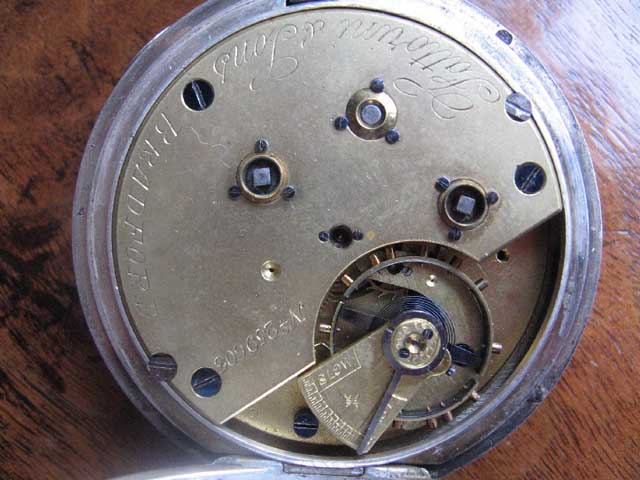 | ||||
|
I thought I would post this watch with center seconds even though it is not a stop watch. 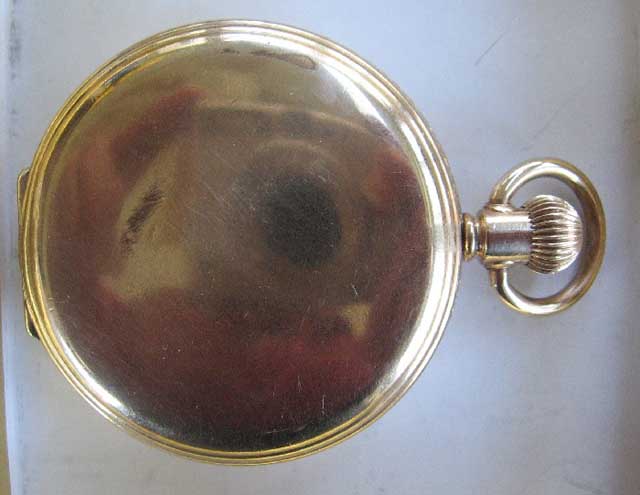 | ||||
|
When I bought it the seconds hand would not turn. 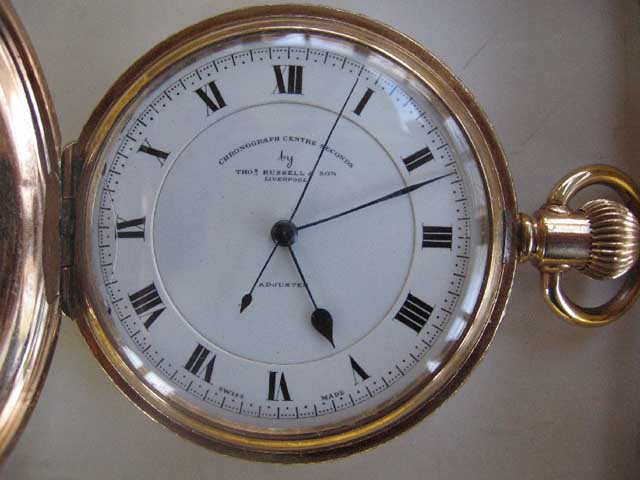 | ||||
|
...because the wheel was missing.  | ||||
|
| Powered by Social Strata | Page 1 2 |
| Your request is being processed... |
|
Welcome Aboard IHC185™  Internet Horology Club 185
Internet Horology Club 185  IHC185™ Discussion Site Main Page
IHC185™ Discussion Site Main Page  Horological Discussions, Questions and Answers
Horological Discussions, Questions and Answers  European Pocket Watch Forum
European Pocket Watch Forum  Is this "Just another Center Sec Chrono"?
Is this "Just another Center Sec Chrono"?
 Internet Horology Club 185
Internet Horology Club 185  IHC185™ Discussion Site Main Page
IHC185™ Discussion Site Main Page  Horological Discussions, Questions and Answers
Horological Discussions, Questions and Answers  European Pocket Watch Forum
European Pocket Watch Forum  Is this "Just another Center Sec Chrono"?
Is this "Just another Center Sec Chrono"?©2002-2025 Internet Horology Club 185™ - Lindell V. Riddle President - All Rights Reserved Worldwide

